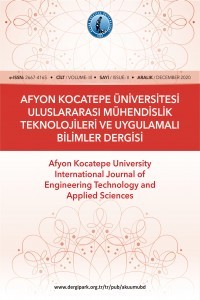Comparison of Flexural Properties of Luffa and Jute Fibers
Luffa fiber, Jute fiber, Bio-composite, Bending, Flexural strength
___
- 1. Acharya, S.K., Mishra, P., Mehar, S.K., Dikshit, V., (2008). Weathering Behavior of Bagasse Fiber Reinforced Polymer Composite. Journal of Reinforced Plastics and Composites 27 (16-17) 1839-1846.
- 2. Balakrishnan, P., John, M.J., Pothen, L., Sreekala, M.S., Thomas, S., (2016). 12 - Natural fibre and polymer matrix composites and their applications in aerospace engineering. Woodhead Publishing.
- 3. Caprino, G., Lopresto, V., Santoro, D., (2007). Ballistic impact behaviour of stitched graphite/epoxy laminates. Composites Science and Technology, 67 (3) 325-335.
- 4. Diharjo, K., Hastuti, S., Triyasmoko, A., Sumarsono, A.G., Putera, D.P., Riyadi, F., et al., (2013). The application of kenaf fiber reinforced polypropylene composite with clay particles for the interior panel of electrical vehicle. in Joint International Conference on Rural Information & Communication Technology and Electric-Vehicle Technology (rICT & ICeV-T), 26-28 Nov. 2013, 1-4.
- 5. Wambua, P., Ivens, J., Verpoest, I., (2003). Natural fibres: can they replace glass in fibre reinforced plastics?. Composites Science and Technology, 63 (9) 1259-1264.
- 6. Bodros, E., Baley, C., (2008). Study of the tensile properties of stinging nettle fibres (Urtica dioica). Materials Letters, 62 (14) 2143-2145.
- 7. Kocak, D., (2008). The Study of the Effects of Different Chemical Compounds Applied on Luffa Cylindrica Fibres with the Help of Ultrasonic Energy. Journal of Polymer Engineering, 28 (8) 501-515.
- 8. Shen, J., Min Xie, Y., Huang, X., Zhou, S., Ruan, D., (2012). Mechanical properties of luffa sponge. Journal of the Mechanical Behavior of Biomedical Materials, 15 (0) 141-152.
- 9. Genc, G., (2015). Dynamic properties of luffa cylindrica fiber reinforced bio-composite beam. Journal of Vibroengineering, 17 (4) 1615-1622.
- 10. Genc, G., Koruk, H., (2017). Identification of the Dynamic Characteristics of Luffa Fiber Reinforced Bio-Composite Plates. Bioresources, 12 (3) 5358-5368.
- 11. Koruk, H., Genc, G., (2015). Investigation of the acoustic properties of bio luffa fiber and composite materials. Materials Letters, 157 (0) 166-168.
- 12. Koruk, H., Genc, G., (2019). 17 - Acoustic and mechanical properties of luffa fiber-reinforced biocomposites. Woodhead Publishing.
- 13. ISO14125, (1999). Fibre-reinforced plastic composites — Determination of flexural properties.
- Yayın Aralığı: Yılda 2 Sayı
- Başlangıç: 2018
- Yayıncı: Afyon Kocatepe Üniversitesi
Sanayi Üretimde Elektrikle İlgili Yaşanan İş Kazalarının Belirlenmesi ve Çözüm Önerileri
Mühendislik Öğrencilerinin Seyahat Tercihlerine Göre Sınıflandırılması
Ali Can TEKİNTAS, Hasan Can TUMANTOZLU, Mahmut Ugur TURKKAN, Kubilay ESİN, Ayse Aycim SELAM
Comparison of Flexural Properties of Luffa and Jute Fibers
Yelizcan TURGUT, Sebahattin Serhat TURGUT, Erdoğan KÜÇÜKÖNER, Erkan KARACABEY
Bitkisel Bir Kompozitin Yüzey Topografyası Basılabilirliğini Nasıl Etkiler?
Sinan SONMEZ, Garip GENC, Huseyin YUCE
Lisakovski Katmanı Of Demir Cevheri Özellikleri
Karlygash SHYNBERGENOVA, Tatyana KRYAZHEVA
Müze Olarak İşlev Kazandırılan Tarihi Bir Yapı; Bursa Umurbey Hamamı
